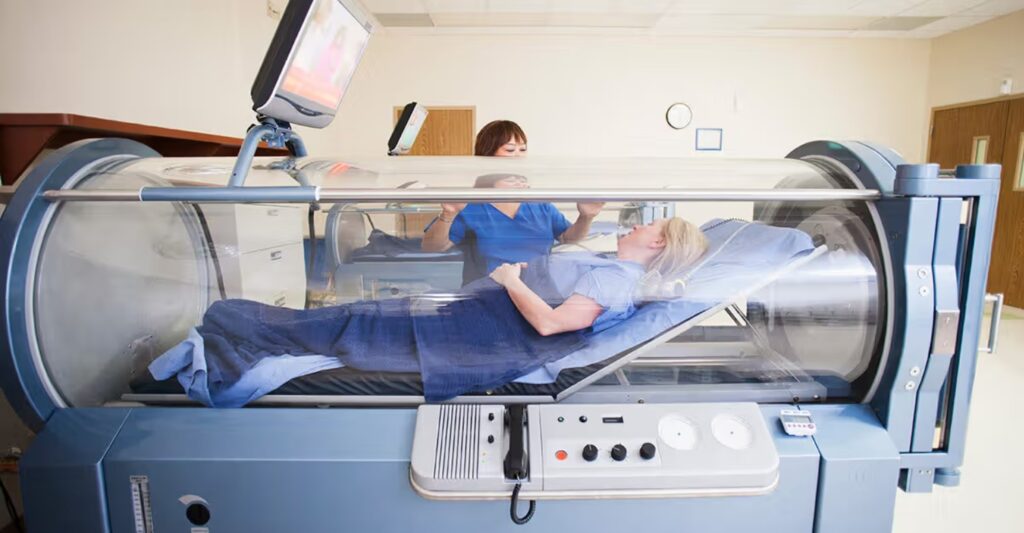Hyperbaric Oxygen Therapy (HBOT) is a medical treatment where patients breathe pure oxygen in a pressurized room or tube. This innovative therapy aims to boost the body’s natural healing process by dramatically increasing the oxygen content in the blood. It has shown potential benefits for a diverse range of medical conditions, from complex wound healing to severe infections, and even some chronic diseases. The therapy’s unique approach to enhancing oxygen delivery to damaged tissues makes it a subject of interest and continuous research in the medical community.
Understanding How HBOT Works

Hyperbaric Oxygen Therapy operates on a simple yet profound principle: under increased pressure, your blood can carry a greater volume of oxygen. In the pressurized chamber, your lungs can gather much more oxygen than would be possible at normal air pressure. This high level of oxygen is then carried throughout the body, promoting healing, fighting bacteria, and stimulating the release of substances called growth factors and stem cells, which foster healing. The therapy’s ability to rapidly increase oxygen levels in the blood and affected tissues is what makes it an effective tool for a variety of medical conditions.
HBOT for Wound Healing
HBOT has gained recognition for its effectiveness in wound healing, particularly for chronic, non-healing wounds. By increasing the oxygen supply to the wound site, Hyperbaric Oxygen Therapy encourages the formation of new blood vessels, reduces swelling, and helps in the fight against infection. Experts in wound care have observed accelerated healing of wounds, including diabetic foot ulcers and wounds resulting from radiation therapy. The therapy is especially beneficial for patients with wounds that have not responded to other treatments, offering a ray of hope for those dealing with chronic wounds. Whether you’re already interested or not, it is vital to check how much does a hyperbaric chamber cost before you commit yourself.
HBOT for Traumatic Brain Injury
The potential of HBOT in treating traumatic brain injuries (TBI) is an area of growing interest. The therapy’s ability to deliver a high concentration of oxygen to the brain can potentially aid in reducing inflammation and promoting recovery of brain function. Experts in neurology and rehabilitation are cautiously optimistic about the role of HBOT in TBI treatment. They suggest that while Hyperbaric Oxygen Therapy shows promise, more research is needed to fully understand its benefits and to establish standardized treatment protocols.
HBOT for Carbon Monoxide Poisoning

HBOT is a well-established treatment for carbon monoxide poisoning. The therapy’s ability to quickly flood the blood with oxygen helps in displacing the carbon monoxide bound to hemoglobin, thereby restoring the oxygen-carrying capacity of the blood. Medical professionals regard Hyperbaric Oxygen Therapy as a lifesaving treatment in severe cases of carbon monoxide poisoning, where it can significantly reduce the risk of long-term neurological and cardiac complications associated with this type of poisoning.
HBOT for Radiation Therapy Side Effects
HBOT has shown effectiveness in alleviating the side effects of radiation therapy, particularly in cases of radiation-induced tissue damage. The therapy’s ability to enhance oxygen delivery to damaged tissues promotes healing and reduces the risk of complications such as osteoradionecrosis and soft tissue radionecrosis. Experts in oncology and radiology value Hyperbaric Oxygen Therapy as a complementary treatment, noting its potential to improve the quality of life for cancer patients undergoing radiation therapy.
HBOT for Diabetic Foot Ulcers
Diabetic foot ulcers are a common and serious complication of diabetes. HBOT has emerged as a valuable treatment option, promoting healing by increasing oxygen levels in the affected tissues. Experts in diabetes care and wound management have observed significant improvements in healing rates and a reduction in the need for amputation among patients treated with Hyperbaric Oxygen Therapy. They emphasize the importance of early intervention and comprehensive care, including HBOT, in managing diabetic foot ulcers effectively.
HBOT for Chronic Wounds

Chronic wounds, such as venous ulcers and pressure ulcers, can be challenging to treat. HBOT offers a promising solution by enhancing the body’s natural healing processes. Wound care specialists recognize the therapy’s ability to improve healing rates and reduce the risk of infection. They note that Hyperbaric Oxygen Therapy can be a valuable addition to a multidisciplinary approach to wound management, particularly for patients with wounds that have not responded to standard treatments.
HBOT for Stroke Recovery
The potential benefits of HBOT in stroke recovery are an area of active research and interest. The therapy’s ability to increase oxygen delivery to the brain may aid in the recovery of brain function and reduce the extent of brain damage. Neurologists and rehabilitation experts are exploring the use of Hyperbaric Oxygen Therapy as part of a comprehensive stroke recovery program. They highlight the need for further research to establish clear guidelines and identify the patients who are most likely to benefit from this therapy.
HBOT for Autism Spectrum Disorders
Hyperbaric Oxygen Therapy has been explored as an alternative therapy for autism spectrum disorders, with the aim of improving symptoms and cognitive function. While the exact mechanism is not fully understood, it is thought that the increased oxygen levels may reduce inflammation and improve neurological function. Experts in the field of autism research are cautiously optimistic, noting that while some patients show improvements, more research is needed to fully understand the potential benefits and limitations of HBOT in treating autism spectrum disorders.
HBOT for Sports Injuries

Athletes are increasingly turning to Hyperbaric Oxygen Therapy as a tool for recovery from sports-related injuries. The therapy’s ability to rapidly increase oxygen levels in the body can significantly reduce recovery time, decrease inflammation, and promote healing of tissues. Sports medicine experts acknowledge the benefits of HBOT for athletes, emphasizing its potential to safely accelerate the healing process and get athletes back to their sport more quickly.
Conclusion and Future Prospects
Hyperbaric Oxygen Therapy has shown promise in treating a wide range of conditions, from wound healing and brain injuries to carbon monoxide poisoning and side effects of radiation therapy. The therapy’s ability to increase oxygen delivery to tissues is at the core of its healing potential. Ongoing research continues to uncover new applications and improve our understanding of how best to use this therapy. As we learn more, the future of HBOT looks bright, with the potential to offer healing and hope to patients facing a variety of medical challenges.

